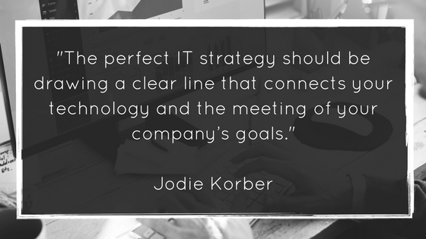If you run a Small to Medium Enterprise (SME), chances are you don’t have an IT strategy. Less than one third of SMEs do. And why would you have one? If it’s not your core business, IT just isn’t that important.
Many CEOs struggle to see where IT can offer added value to their business. The IT team is there to fix things when they break, or add new things just as they're needed. Having IT as part of the strategic planning process doesn’t seem necessary.

If your business has experienced growth recently, the technology systems you started out with probably aren’t serving your needs as well as they once did.
But if taking a patchwork approach to your business’ IT has worked for you so far, why change? As they say – if it ain’t broke, don’t fix it.
But if developing an IT strategy was guaranteed to save you time, money and frustrations in the long term - would you think differently?
Have you ever bought an expensive software tool only to find that no-one’s using it? Or that the impact it had on your business was not what you anticipated? This is the kind of thing you can avoid when you have an IT strategy. Any technology decisions are made to benefit the business in some way, rather than being on a reactive, ad hoc basis.
Kicking Business Goals
An IT strategy is really just about making IT work for your business, rather than alongside it. You may know how you want the technology to work for your business but don't understand how to make it actually happen, and that’s fine. All you need to do is share your business strategy with the IT department, and they’ll take care of the ‘high tech’ stuff.
For example, let’s say you’ve set yourself the goal of offering the best customer service in the industry.
Depending on your business IT might recommend:
- a simpler online interface to improve the customer journey
- a bespoke automatic marketing system on the back-end to promote cross-sell
- and a digital portal for customers to access extra information and see the progress of their project.
That’s potentially a huge step towards achieving your goal – and it came from getting IT involved at the strategy stage.
When IT understands the aims of the business, they can start to ask the right questions, and plan to build the right solutions...
If you don’t have a business strategy, it’s an opportunity to develop one involving IT. Your IT manager can assist in providing quick answers as to what may or may not be achieved and help point out any major advantages or disadvantages that IT will bring to the execution of the proposed strategy.
Unless you factor IT into your strategic planning or, even better, get the IT department involved then you’re going to be stuck trying to take over the world with the dated infrastructure you have now, with your IT team chasing and trying to build systems on the run.
No more guesswork
So, in an ideal world, what should your business technology strategy be doing for you? At its very core, the perfect IT strategy should be drawing a clear line that connects your technology and the meeting of your company’s goals.
You shouldn’t have technology for technology’s sake – your IT should be serving the needs of the organisation. A good IT strategy is driven by business requirements and future plans. Unless these are aligned, the strategy is no more than guesswork.
Technology could be your competitive advantage – or it could be your competitor’s advantage. You decide.
To understand more about IT being key to business success download the ebook, “Why your companies IT strategy is Key to business Success.”
Related articles: Business Continuity Strategy delivers a return on investment for SMEs

We’re creating a business that provides unlimited potential for our team. We believe that each and every team member has an equal opportunity to play a strategic and impactful role.
GET IN TOUCH
